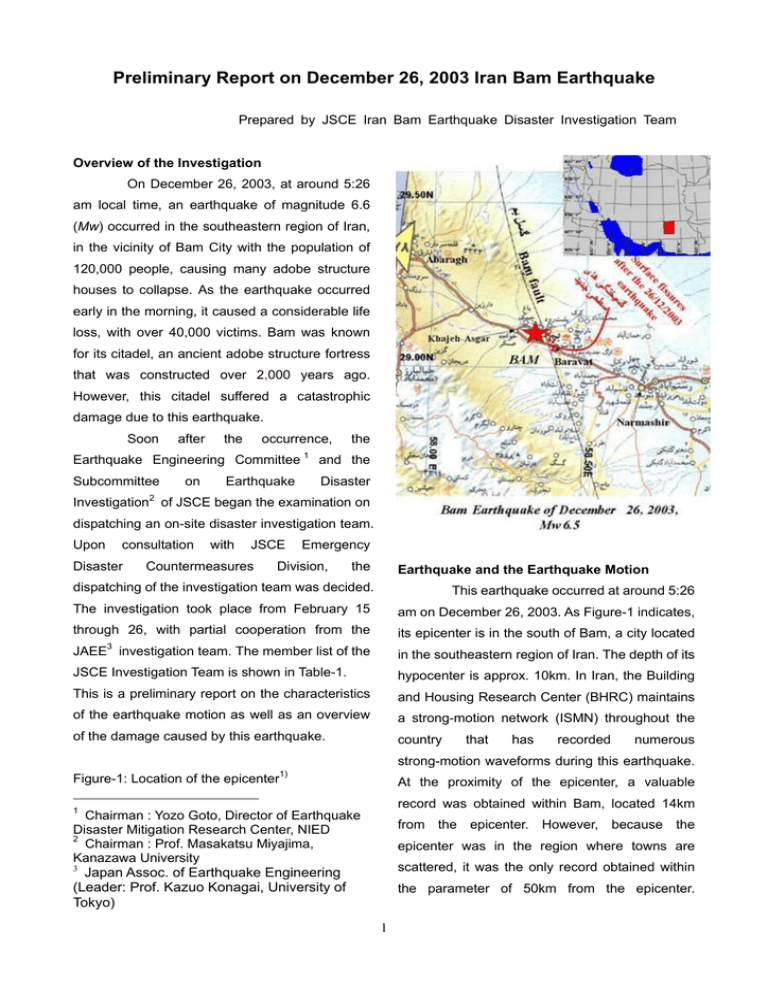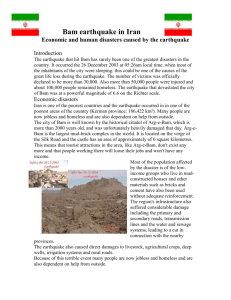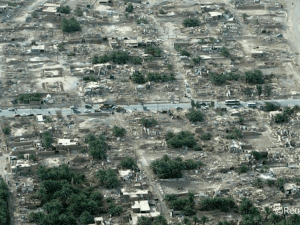Preliminary Report on December 26, 2003 Iran Bam Earthquake
advertisement

Preliminary Report on December 26, 2003 Iran Bam Earthquake Prepared by JSCE Iran Bam Earthquake Disaster Investigation Team Overview of the Investigation On December 26, 2003, at around 5:26 am local time, an earthquake of magnitude 6.6 (Mw) occurred in the southeastern region of Iran, in the vicinity of Bam City with the population of 120,000 people, causing many adobe structure houses to collapse. As the earthquake occurred early in the morning, it caused a considerable life loss, with over 40,000 victims. Bam was known for its citadel, an ancient adobe structure fortress that was constructed over 2,000 years ago. However, this citadel suffered a catastrophic damage due to this earthquake. Soon after the occurrence, the Earthquake Engineering Committee 1 and the Subcommittee on Earthquake Disaster Investigation2 of JSCE began the examination on dispatching an on-site disaster investigation team. Upon consultation Disaster with JSCE Countermeasures Emergency Division, the Earthquake and the Earthquake Motion dispatching of the investigation team was decided. This earthquake occurred at around 5:26 The investigation took place from February 15 am on December 26, 2003. As Figure-1 indicates, through 26, with partial cooperation from the its epicenter is in the south of Bam, a city located JAEE3 investigation team. The member list of the in the southeastern region of Iran. The depth of its JSCE Investigation Team is shown in Table-1. hypocenter is approx. 10km. In Iran, the Building This is a preliminary report on the characteristics and Housing Research Center (BHRC) maintains of the earthquake motion as well as an overview a strong-motion network (ISMN) throughout the of the damage caused by this earthquake. country that has recorded numerous strong-motion waveforms during this earthquake. Figure-1: Location of the epicenter1) At the proximity of the epicenter, a valuable record was obtained within Bam, located 14km 1 Chairman : Yozo Goto, Director of Earthquake Disaster Mitigation Research Center, NIED 2 Chairman : Prof. Masakatsu Miyajima, Kanazawa University 3 Japan Assoc. of Earthquake Engineering (Leader: Prof. Kazuo Konagai, University of Tokyo) from the epicenter. However, because the epicenter was in the region where towns are scattered, it was the only record obtained within the parameter of 50km from the epicenter. 1 Table-2 shows the maximum acceleration at the city of Bam. At the site, an almost continuous various sites. In Bam, a vertical motion of over 1G stretch of scarp that has been formed by the past is observed, and the horizontal motion has fault movements extends in the north-south marked a very high value of 800gal as well. direction. This scarp has a relative height of 20m Figure-2 is the strong motion waveforms that with its higher point on the west side. Photo-1 is BHRC disclosed. It may be considered that the an aerial photo showing the cities of Bam horizontal the (western green area) and of Baravat (eastern characteristic of the site near the fault. As the green area). The white area stretching from north strong-motion seismograph was placed under a to south, in between the two cities is the flexural desk, on the first floor of a two-storied concrete scarp. The Bam fault is a right lateral reverse fault reinforced brick structure, there was no impact but it is considered that the fault did not reach the from falling objects. However, as the adjacent ground locker fell, there is a possibility that the record development of the flexural scarp. Photo-2 shows reflects the impact of this fall, or of the shaking of a fissure that appeared on the road traversing the the structure itself, which was partly damaged. flexural scarp. It is not considered a slip surface of component (L) expresses surface and was limited to the the epicentral fault but an open fissure caused by the development of the flexural scarp. Photo-1: Aerial photo of Bam and Baravat Figure-2: Strong-motion seismograms recorded in the city of Bam2) (From the top: horizontal, vertical, horizontal-transverse components. The maximum rates are shown in Table-2) Photo-2: Crack on the road traversing the flexural scarp The Bam fault lies approx. 2km east of 2 to over 0.4 static friction coefficient was in action. Topography and the Geological Conditions The City of Bam is located in the 2) Water Tower southwestern part of Lut Desert. The city is Damages were observed in a reinforced developed around oases in the periphery of the concrete water tower located at the center of the fault scarp at the edge of an alluvial fan. Although stricken area, where the concrete that was an outcrop is observed at the Bam Citadel in the covering the lower end of its pillar was stripped off northeastern part of the city, according to the and the reinforcing steel bar (in the direction of preliminary figures we have obtained through the axis) was exposed and buckled (Figure-3). microtremor observation, the thickness of the The pillars were placed octagonally, in a sedimentary layer does not simply increase from rigid-frame structure with mid-layer beams. In north to south. More details will be reported at a order to grasp the dynamic bearing capacity of later time at the preliminary debriefing session, the water tower, we have undertaken a static after organizing the results from microtremor increasing horizontal seismic coefficient analysis observation and from other materials collected. using a frame model. Figure-4 indicates the relationship between horizontal seismic coefficient and horizontal displacement at the Damages to Public Infrastructure Table-3 indicates the degree of damages center of gravity of the water supply tank. The seen on typical public infrastructures that we have result of the analysis shows that after the point investigated in Bam and in Baravat. The where the lower end of the pillar yielded, the characteristic of these structures is that due to slope of the curve became gradual. Therefore, it their importance, a relatively large number of may be considered that the yield horizontal them are concrete reinforced and thus, the seismic coefficient of the entire water tower was damages to them are relatively small. Following is approx. 0.37, and the horizontal acceleration the characteristics of damages described by the equivalent to over 370gal of earthquake motion types of representative structures: was in action. Moreover, the damages such as 1) Bridges the stripped concrete cover of the western pillar We have investigated concrete due to tension, and the buckled reinforcing steel reinforced bridges at three locations around Bam. bar of the eastern pillar due to the compression As a result, we have observed damage in only suggest that the westward action perpendicular to one of them, near the Bam Citadel, in which the the fault was dominant. 12,000 girder has shifted 2 cm west in the direction 0 00 5, Supply Tank perpendicular to the bridge axis (perpendicular to 00 5 ,7 the fault) and a crack was observed on one abutment. All of the bridges had reinforced concrete girders and wall-type RC piers, which is 1-1Section a style commonly used in bridging small to 1 medium size rivers in Japan as well. Due to the ・Concrete cover stripped off ・Reinforcing steel bar buckled fact that the reinforced concrete girders have shifted, although slightly, it may be considered ( Unit : mm ) that the horizontal seismic coefficient equivalent Figure-3: Structure of the Water Tower 3 1 050 ,7 00 0 ,2 0.6 Horizontal Seismic Coefficient Damages to Lifelines 0.4 khy=0.368 This earthquake caused the greatest khy=0.3689 (Lower end of the functional damage on roads. Bam and the state compressed pillar yielded) capital, Kerman are linked by a two-lane road, 0.2 which become congested due to relief / rescue activities soon after the earthquake hit. We have 0.0 been reported that an approx. two-hour trip Horizontal Displacement (m) between the two cities at ordinary times took Figure-4 more than 6 hours due to congestion during the 3) Mosques As afternoon of the occurrence. Therefore, the air reinforced route was used as the alternative facility. smaller Although the control tower of Bam’s private damages than brick or adobe structure ones. airport had suffered damage, it was replaced by However, brick walls have collapsed even in another control facility that was immediately reinforced concrete mosques. Photo-3 shows a installed on the ground and the special flights mosque where the collapse of the wall has began to take off and land in the evening of the claimed 7 lives. Yet, compared to brick houses, occurrence. Almost 500 departures and arrivals these structures suffered smaller, B-degree within the 12-hour period enabled the transport of damages. This may be due to the effect of the patients in critical conditions to Kerman or the difference in the quality of building materials used. Capital, Teheran, as well as the transport of Whereas ordinary houses are built with bricks by relief/rescue workers and materials to the afflicted the residents themselves, due to their large scale, area. concrete in other mosques structures, have suffered mosques are built with high quality mortar by The water supply systems in both Bam professional construction workers. and in Baravat suffered no damage in tanks and other facilities, except in the underground pipes. The underground pipes made of Asbestos-cement, P.V.C. and polyethylene were damaged at their T or straight joints as well as at their body. There have been a great number of collapsed houses and due to that, excavation work has been impossible in many areas. In many of these areas, temporary ground pipe systems have been introduced. For residents living in tents, water tanks like the one shown in Photo-3: A damaged mosque Photo-4 were supplied. 4 others. From now, we plan to proceed with the examination on relationships among ground characteristics, earthquake motion and structural damages. Acknowledgement We would like to acknowledge and thank the great efforts of the members of Emergency Disaster Countermeasures Division, Earthquake Engineering Committee, and Subcommittee on Photo-4: Water tank supplied to the residents Earthquake Disaster Investigation of JSCE in dispatching the investigation team. We would also The gas network is not established and like to thank Professor Kazuo Konagai of the in their place, compressed gas cylinders are used. University of Tokyo for his work as the contact As for the sewage, we have been reported that it with the local counterpart, and for leading the joint is directly discharged at a considerable depth team during on-site investigation. Lastly, we from the ground surface. would like to thank all those who were involved from IIEES (International Institute of Earthquake Damages to structures Engineering and Seismology), Teheran University, There are many adobe structure houses and BHRC for accompanying us on the on-site in central Bam, and most of them have collapsed. investigation, for making various arrangements, In the same area, there are many non-reinforced and for providing valuable information. brick houses, which have collapsed as well. The rate of collapse is said to amount to 80-90%. As References: shown in Photo-5, there are many areas that are 1) Sassan Eshghi and Medhi Zare: Bam (SE covered with heaps of rubbles, and the next Iran) Earthquake of 26 December 2003, Mw important task there would be to remove these 6.5: A Preliminary Reconnaissance Report, rubbles and to plan the reconstruction. During the on-site investigation, we have 2004. undertaken 2) Building and Housing Research Center: The in-person hearings on questionnaire seismic Very Urgent Preliminary Report on Bam intensity and microtremor observation among Earthquake of Dec. 26-2003, 200 Photo-5: Collapsed adobe structure houses 5 Table-1: Member list of the investigation team (* different schedule) Title Main Areas of Investigation Name Affiliation Team Leader Site characteristics, Lifeline MIYAJIMA Masakatsu Kanazawa University MEGURO Kimiro University of Tokyo HAKUNO Motohiko Kogyokusha College of Structural damage Vice Team Leader Emergency response Member Damage distribution Technology Member Structural damage KOSA Kenji Kyushu Institute of Tech. Member Ground destruction TOBITA Tetsuo Kyoto University Member Remote sensing TAKASHIMA Masasuke University of Tokyo Member Reconstruction strategy YOSHIMURA Miho University of Tokyo Member Adobe structure MAYORCA Paola University of Tokyo Member Site characteristics FALLAHI Abdolhossein Kanazawa University Emergency response Pacific Consultants, Co. Member* HAYASHI Akio Reconstruction plan Member* Ltd. Lifeline KUWATA Yasuko Kobe University Table-2: Maximum acceleration obtained and the distance to the epicenter Maximum Acceleration (gal) Observation Distance to the Station epicenter (km) Horizontal (L) Horizontal (T) Vertical (m) Bam 14 799.06 636.37 988.50 1094 Mohamad 60 123.52 71.40 70.74 1961 Jiroft 88 40.33 28.30 31.81 725 Golbaf 99 30.78 29.46 13.70 1698 Rein 102 21.94 18.08 22.95 2195 Jushan 127 24.99 36.64 17.52 1650 6 Elevation Table-3: Degree of Damage of Typical Structures Kinds of Degrees of No. Principal Material Structure Note Damage No. 1 RC C 14 spans (simple girders) No. 2 RC D 3 spans (simple girder) No. 3 RC D 7 spans (simple girder) Water Tower No. 1 RC C Reinforcing steel bar buckled City Hall No. 1 Adobe A Total collapse No. 1 Brick A Center pillar made of steel No. 2 Adobe A Center pillar made of steel No. 3 RC B Reinforcing steel bar buckled No. 4 RC C Occurrence of crack on the pillar only No. 5 Brick B Steel center pillar, wall collapsed No. 6 Adobe A Total collapse No. 7 Brick B Center pillar made of steel No. 8 Brick B Center pillar made of steel No. 9 RC C Occurrence of crack on the pillar only Bridges Mosques Degrees of damage: A= Collapse, B= Medium, C= Light, D= No Damage 7





